Google Ads Secrets: How to Spy on Competitors Adwords Edition



Online marketing is constantly changing. But there’s one thing that seems to remain the same and that’s competition.
If you want to keep your business growing, you need to keep finding new ways to stand out. Fail to do so and you’re bound to be forgotten.
Here’s the good news. Success is in sight, with the right tools and approach.
One of those tools is Google Adwords, now called Google Ads.
It’s proven itself as one of the most useful tools, allowing businesses worldwide to reach their audience. eMarketer estimates that Google’s net U.S. digital ad revenue will reach $39.58 billion in 2020, a decline of 5.3% from $41.80 billion in 2019 due to the pandemic downturn. Post pandemic ad revenue for Google however, is expected to rebound. Ad volume is projected to grow by 20.9% in 2021 reaching an astounding $47.85 billion.
Most companies use Google Ads to drive ready-to-buy traffic to their website. But did you know you can also use it to keep track of your competitors’ strategies?
It’s true!
There are several reasons why Google Ads competitors analysis matters for your marketing, and more importantly for your business.
Why competitor research matters
1. You can take a shortcut to the right content marketing formula.
No matter your industry, there’s a high chance that you’re not the first one there.
In fact, leaders in your industry have probably “tried and failed” many times on their way to the coveted top position.
So looking at what they’re doing can simplify things by a lot. It can also help you avoid making the same mistakes they made.
This can save you time, money and untold levels of frustration! More importantly, it can help you find the right formula to quickly grow your business online.
2. You can scope the market for new competitors.
Ads allow you to understand the collective behaviour of your competition.
By using the right tools, you can learn who exactly you are competing with for consumers.
And even if you already know this, you can find some very interesting data about your competitors. You can look up new keywords, auction stats, and all kinds of useful information.
All of this will result in better preparation.
And preparation is paramount.
Once you’re familiar with what you’re dealing with, you can think ahead of others.
If this sounds appealing, keep on reading.
What competitor insights should you look for?
Luckily, on Google Ads, your competitors are very visible. In fact, every time you search for something related to your products, you’ll find your competitors’ ads staring you in the face.
Most business owners have the immediate urge to find a way to get their ads on top of competitors. But, since there’s no quick way of knowing whether your competitors’ campaigns are profitable, this isn’t always the best strategy.
If you want to spend more to outrank your competitors, it’s good to start by getting information.
How much are your competitors spending? What keywords are they using in their advertisements? And most importantly, how profitable are their campaigns?
In this article, we’ll show you how to find out exactly what your Google Ads competitors are doing – and how to use it to your benefit.
Which competitors are using Google Ads?
The first step to finding out what your Google Ads competitors are doing is finding out who is advertising on Google Ads. The easiest way to do this is to search a couple of keywords and see which advertisers pop up.
That being said, it’s important to note that this approach doesn’t give you a realistic idea of the whole playing field. Competitors’ may have configured their ads to only show during certain times., or have exhausted their ad budget for the day. Furthermore, since results are limited to the location and language of your browser, some competitors’ ads may not show up.
For the advertisers that show up, you can look at their data with SimilarWeb. Once you plug in the URLs you’ve found, scroll down to the Traffic Source report:
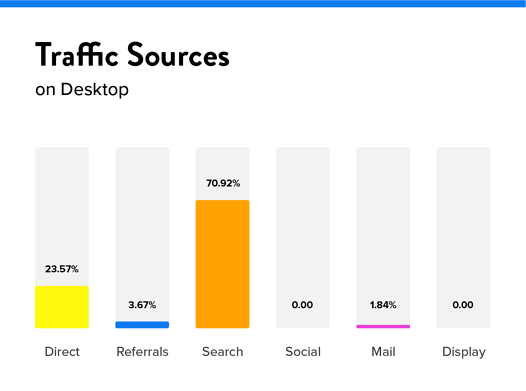
This report shows you the traffic sources of the website(s) searched.
Then, scroll down to the Search section, where you’ll see the split between organic and paid traffic:
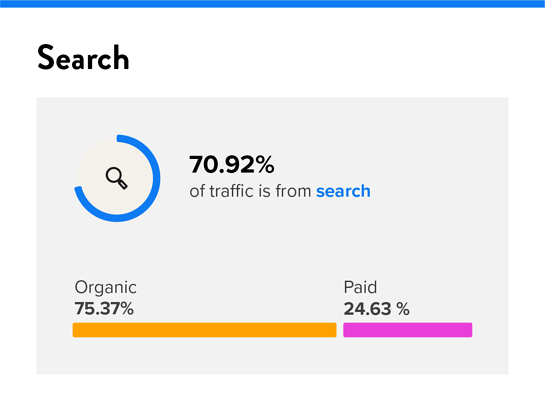
The best PPC tools to help you spy on your competitors
Before we dive into the nitty-gritty, let’s review the best Google Adwords spy tools out there for gaining an edge over your competitors.
1. Auction Insights via Google Ads Campaign
The Auction Insights tool allows you to see other domains entering the same Google ad auctions at the campaign, ad group, and keyword level. Additionally, it provides information on how well your ads are performing in comparison with other advertisers.
2. SimilarWeb
SimilarWeb allows you to find out your competitor’s monthly traffic, which channels bring the most visitors, and specifically where these visitors come from.
3. Ahrefs
Ahrefs can be utilised for all aspects of your competitor analysis. It will show you things like top pages, IPs, and external links regarding your competitors. Ahrefs is also an excellent tool for ad keyword research and analysis.
4. SEMRush
SEMRush specialises in competitor data. You can use SEMRush to get ad keywords and the traffic numbers of your competitors.
5. iSpionage
iSpionage is a keyword monitoring tool that allows you to type in a competitor and see the best performing keywords for organic as well as for PPC (in both Google and Bing). In addition to the PPC keyword list and metrics, you can also find out how much your competitors are spending on their PPC campaigns, all of which is crucial data for keeping your conversion rates high and costs low.
6. SpyFu
SpyFu is a simple and effective tool for finding out your competitor’s top paid keywords, the CPC (cost per click), and the monthly cost. If you know where your competitors are spending their dollars, you can decide which keywords are worth pursuing.
7. KeywordSpy
KeywordSpy allows you to see a competitor’s keywords, domains, ad copy, and AdWords spend. Their software will also suggest specific keyword and ad combinations deemed profitable.
Using Google Ad Auction Insights
If you are already running Google Ads campaigns, you can get more detailed information from the Google Ads Auction Insights report. This report will tell you how you compare to other advertisers for your whole account, a specific campaign, or a specific ad group.
You can access it by clicking on any active ads campaign and going to the ‘Auction Insight’ tab. Once you open it, select ‘All’.

(Image Source: Wordstream)
This will give you a variety of useful reports.
Here are some of the things that you can find out about your competitors:
- Average ad position
- Impression share
- Quality Score
- Overlap rate (the frequency which your competitors’ ads show up next to yours)
- Position-above rate (the frequency which your ads have outperformed your competitors’)
You’ll get a report that’s easy to navigate and find the right information.

(Image Source: Search Engine Land)
Taking inputs from the data generated, you could decide where you must slow down and where you need to act more aggressively.
Here is a look at the metrics shown on an Auction Insights report:
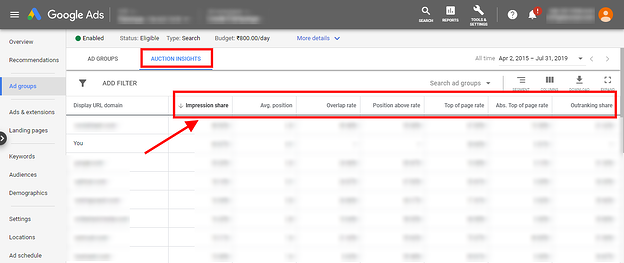
(Image Source: Karooya)
Which device type is competitive?
The Auction Insights report also sheds light on the device your competitors are predominant on. You can use this feature of the report to identify which device is being used by competitors for a specific keyword or set of keywords. This tells you which device type you should increase your bids for and helps you create a better overall device strategy.
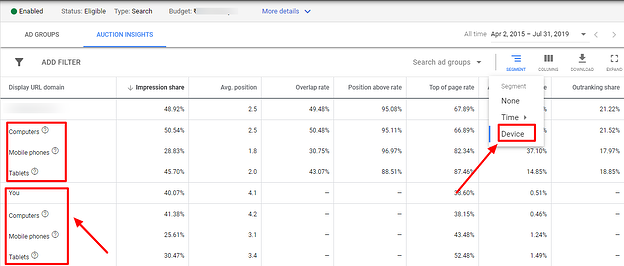
(Image Source: Karooya)
How are you performing for a keyword?
You can also use the Auction Insights report to check how you’re performing for a keyword. For example, you could filter keywords with a high CPA (cost per action). If there is less competition, you could reduce the CPA by reducing the bids. You can also use other metrics (quality score, bidding strategy, below first page, etc) to filter and analyze your keywords and identify patterns.
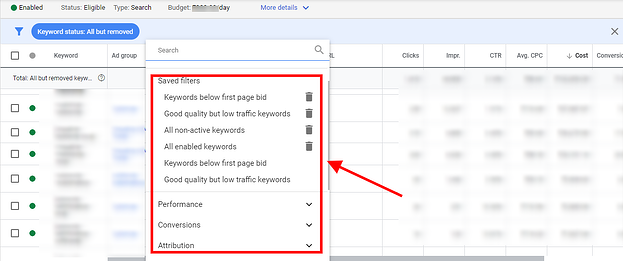
(Image Source: Karooya)
How much ad traffic do your competitors get?
Again, if you’re running a Google Ads campaign, the Auction Insights tool can again prove itself a great source of information. You’ll want to pay particularly close attention to the impression share and outranking share.
The impression share tells you how often your ad received an impression. It’s calculated as the impression received divided by the total eligible impressions.
The impression share metric also tells you about how often your competitor’s ad received an impression as a proportion of the auctions your ad was competing for. This information enables you to find out how your ad is reaching out to people. You can also analyze whether by increasing your bids there has been an improvement in your impression share.
The outranking share allows you to find out the times your ad ranked higher than the advertiser’s during the auction. In other words, this column reflects whether your bidding strategy to outrank a specific competitor has been successful or not.
In the following example, Advertiser A’s outranking share is low at 21%. This implies that the advertiser ranks higher in most auctions. Since you can only outrank one competitor at a time, you’d start with Advertiser A and increase your bids to rank better.

(Image Source: Karooya)
Not using Google Ads campaigns?
If you’re not running Google Ads campaigns, there are a ton of keyword/PPC tools that specialise in giving competitive research information. We’ll get into that a bit later on in this article, so keep reading.
What are your competitors’ top keywords?
It’s time to dig deeper and discover the Google Ads keywords that your competitors are advertising on.
Ahrefs and SEMRush are both great tools for keyword research.
Here is an example of a report pulled from Ahrefs:
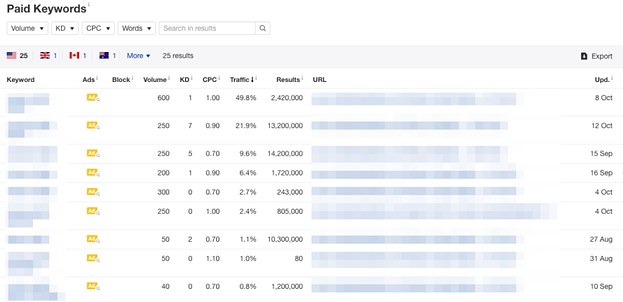
Whereas here is an example of a report pulled from SEMRush:
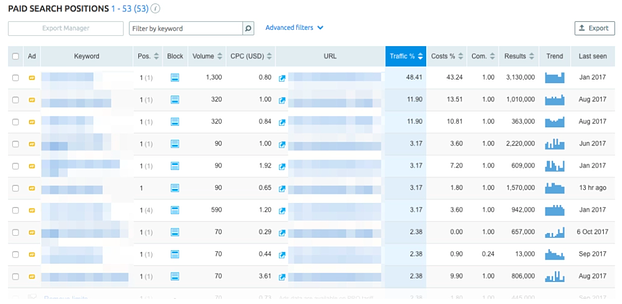
Both tools offer a solid overview of the keywords, their monthly search volumes, and their estimated CPCs.
The traffic % and cost %, however, give you more insights and allow you to quickly focus on the most important keywords.
You can also use iSpionage to find profitable keywords based on what your competitors are using.
iSpionage also comes in handy for knowing how much your competitors are spending on their PPC campaigns.
Once you’ve created an account and logged in, conduct a URL search for your brand.

(Image Source: iSpionage)
Next, click on the “Competitors” tab to view your top competitors in AdWords and Bing.
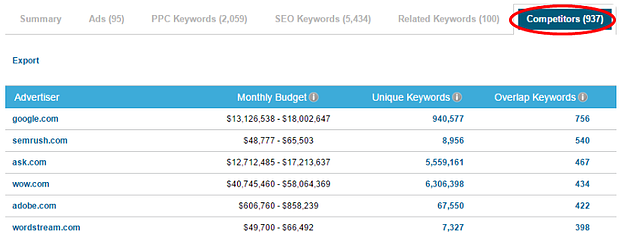
(Image Source: iSpionage)
Next, look at the columns for unique keywords and overlap keywords to learn which terms you’re both bidding on and which ones your competitors are bidding on that you are not. If they’re a direct competitor, there’s a good change you will find new profitable keywords by adding those terms to your campaign.
Finally, you can go one step further and export the unique keywords as a .CSV. This makes it easier to sort, organize, and work with the terms you’d like to add to your campaign.
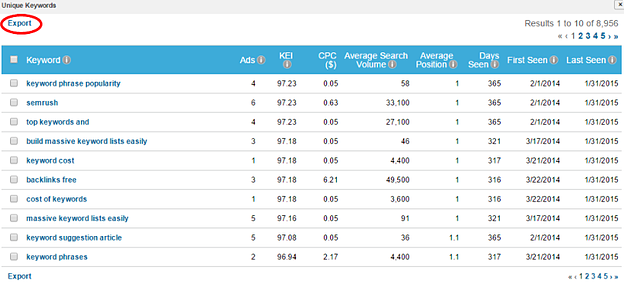
(Image Source: iSpionage)
4 tips for highly effective Google Ads competitor analysis
Now that you know how beneficial spying on the competition can be, let’s go over tips to do it well.
The good news is it’s fairly simple and pretty much anyone can be successful. And you can find lots of actionable information, if you know where to look.
1. Search for your main keywords
By now, everyone in the SEO world knows why finding the right keywords is a top priority.
The right combination of keywords can make or break your campaign.
Still, many people settle for the same keywords, meaning standing out from the crowd becomes all too difficult. The main challenge comes in finding great keywords that your competitors haven’t targeted.
So, here’s the first thing to do: search for your core keywords and see who shows up next to your ads.
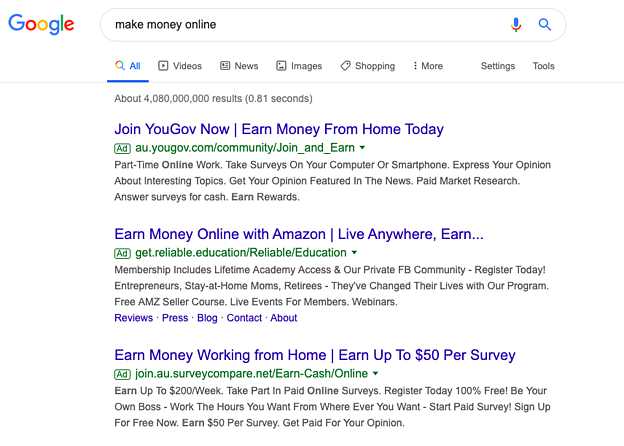
Keep in mind that this is just something that you should start with. Your goal here is simply to see which businesses you’re fighting against.
Which competitors are vying for the top ad spots?
What kind of language are they using in their ad copy? Is it action-oriented? Aspirational or fear-driven?
Then you can dig deeper.
Do their ads match the language used in the query? If not, you may have identified an opportunity to create a more relevant ad that climbs above theirs.
What about their landing pages? Are they relevant to the search query? Relevance affects quality score. If you can build a more relevant landing page for a keyword than your competitor, you’ve identified a keyword to target.
You’re aiming to see who your competitors are and how much effort they’re putting into targeting each keyword.
If you do this many times, you’ll hurt your own CTR, since you’re creating impressions that don’t result in clicks.
Once you’ve identified who they are, you can move on to the more detailed tools.
2. Use Auction Insights
As you already know, Google Ads lets you obtain all kinds of useful information about your competitors’ campaigns.
Auction Insights in particular can prove to be very useful.
You can choose whether you want to see the reports at the ad group, campaign, or even the individual keyword level.
This will give you an insight into your competitor’s ranking, as well as the reasons behind it. For example, you may see that you have a low Position-Above Rate compared to a competitor. That means they’re doing something with their ads that you’re not doing. You can then seek out the ad to check its copy and landing page.
In summary, Auction Insights helps you take a very close look at what the competition is doing, without the need for third-party tools.
You can use all of the information to jump ahead of your competition.
Powerful stuff.
3. Use SpyFu to find your competitors’ keywords
SpyFu is one of the best tools for keyword competitor research.
It saves a load of time and gives detailed insight into your competitors’ campaigns. It’s a dedicated competitor research tool.
As a result, you don’t have to waste time wading through unnecessary information.
The tool gives you the insights you need right off the bat.
Here’s how it works.
All you have to do is simply enter the domain name of your competitor in the search box.
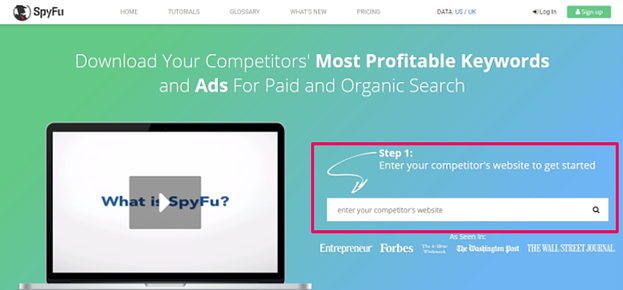
(Image Source: Neil Patel)
This is why the first step earlier in this article is so important.
After you’ve seen who your competitors are, you can then use SpyFu to get a closer look at what they’re doing.
By far the most useful feature that you’ll see is the History feature.
This is where you get to actually see what has worked for your competitors.
You’ll get insights into how their previous ads performed, as well as the most profitable and effective keywords that they’ve used.
This lowers the chance of you swinging and missing with your keywords, since you can know beforehand the best ones to incorporate into your campaign.
Just imagine the time and money saving this little nifty feature can deliver to you!
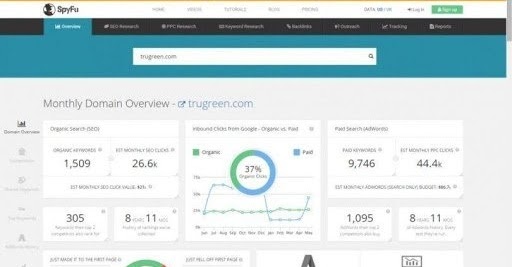
(Source: Top Best Alternatives)
Another crucial piece of information are the paid keywords that your competitors have used.
If you look deeper into the reports, you’ll find a tonne of information that you can use.
One of the best things about this is that it takes far less effort than many other solutions.
That’s because there’s no manual keyword research.
Almost instantly you can get virtually all information that you need to tweak your campaign. More importantly, this is information that’s extracted from actual campaigns that your competition have invested money on.
4. Compare the Competition with SEMrush
If you’re willing to invest a little into getting even more data, SEMrush is the way to go.
It provides a comprehensive collection of tools that you can use to get valuable insights into your competition. Amongst dozens of features you get:
- Learn about new organic competitors
- Distinguish the keywords that have worked for them
- Uncover the keywords that didn’t
And more…
You also get a very detailed analysis that covers pretty much every aspect of your competitor’s keyword usage.
You can even get real-time updates on organic search results of all the keywords that you’re looking into.
Sounds nice, doesn’t it?
Take a look below at how much information you can glean at a glance.
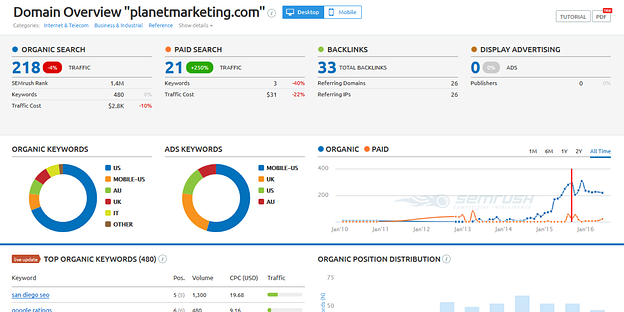
(Image Source: Planet Marketing)
But it doesn’t end there…
Another extremely useful feature is the Topic Research button.
This is a great time saver if you want to craft new content on your website.
You just enter the search term, and SEMrush shows you the content that your competitors have already created on the topic.
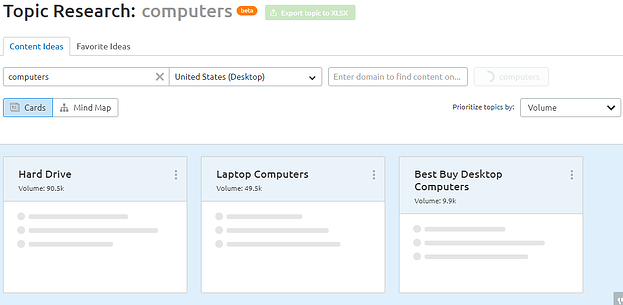
(Image Source: Neil Patel)
It also gives you insight into the questions your customers want answers to. Which means it makes it almost effortless to decide what content to write about in order to bring in more traffic.
Normally, you’d have to manually go through your competitors’ content to uncover this information. But the Topic Research tool eliminates the need for this.
Conclusion
In summary, the tools you saw here can help you:
- Identify your competitors
- Learn about their previous campaigns and results
- Get all the information you need on the keywords that they’re using
- Use the data you collect to create a superior strategy
This is more than enough for you to stay in the game and become one of the best players.
Combining these tools can get you ahead of the competition and ensure that you stay there.
Interested in what OMG could potentially offer?
Let us help you make 10x your traffic, leads, and sales through the power of masterful SEO and PPC!



